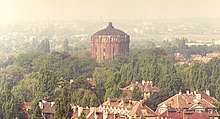Haze (atmosphere)

The term haze refers to the clouding of the earth's atmosphere by water droplets or aerosols (solid suspended particles). Meteorological terms for this are hydro- or lithometeors .
An accumulation of haze over cities is also referred to in everyday language as a vapor hood or hood .
| damp haze | |
| dry haze | |
| Dust haze |
In contrast to fog , haze is much less dense, with a visibility of more than a kilometer. From a visibility of eight kilometers or more, the cloudiness is too weak to speak of haze, although in some cases this limit is set at a visibility of five kilometers. In addition to this optical feature, the two phenomena can be physically differentiated by the fact that water vapor saturation in the air is fog and unsaturated air is haze. Like fog, and in contrast to a cloud , haze always has contact with the ground. In seafaring in particular, one speaks of hazy weather instead of haze .
As a rule, haze is created by condensation of the water vapor contained in the air , provided the humidity is high enough for this and a sufficiently large number of aerosol particles is present. The latter act as condensation nuclei and are indispensable for the formation of droplets via heterogeneous nucleation , but can also appear as haze themselves if the concentration is sufficiently high, which is then referred to as dry haze. The limit of definition between moist and dry haze, which always contains a certain amount of moisture, is a relative humidity of 80%. In addition, one speaks of dust haze when some of the suspended particles are large enough to be seen with the eye.
Condensation below the saturation point occurs due to the hygroscopic properties of the aerosol particles. The droplets can only grow as far as the ability of the particles to bind moisture is not compensated by the increasing influence of surface forces. The maximum achievable droplet size is therefore limited and is normally in the range from 0.1 to 1 μm.
Haze - and especially dry haze - is created above all in inversion weather conditions , when the vertical exchange of air is interrupted. In conurbations with high levels of air pollution , this sometimes occurs in the form of smog , which is still a haze even when visibility is less than one kilometer.
See also
Web links
Individual evidence
- ↑ haze or hood after Mackensen - Large German Dictionary , 1977
